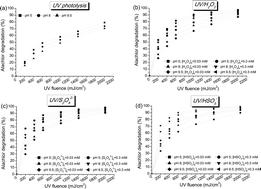当前位置:
X-MOL 学术
›
Environ. Sci.: Water Res. Technol.
›
论文详情
Our official English website, www.x-mol.net, welcomes your feedback! (Note: you will need to create a separate account there.)
Degradation of a chloroacetanilide herbicide in natural waters using UV activated hydrogen peroxide, persulfate and peroxymonosulfate processes
Environmental Science: Water Research & Technology ( IF 5 ) Pub Date : 2020-08-05 , DOI: 10.1039/d0ew00358a Jelena Molnar Jazić 1, 2, 3, 4, 5 , Tajana Đurkić 1, 2, 3, 4, 5 , Bojan Bašić 1, 2, 4, 5, 6 , Malcolm Watson 1, 2, 3, 4, 5 , Tamara Apostolović 1, 2, 3, 4, 5 , Aleksandra Tubić 1, 2, 3, 4, 5 , Jasmina Agbaba 1, 2, 3, 4, 5
Environmental Science: Water Research & Technology ( IF 5 ) Pub Date : 2020-08-05 , DOI: 10.1039/d0ew00358a Jelena Molnar Jazić 1, 2, 3, 4, 5 , Tajana Đurkić 1, 2, 3, 4, 5 , Bojan Bašić 1, 2, 4, 5, 6 , Malcolm Watson 1, 2, 3, 4, 5 , Tamara Apostolović 1, 2, 3, 4, 5 , Aleksandra Tubić 1, 2, 3, 4, 5 , Jasmina Agbaba 1, 2, 3, 4, 5
Affiliation

|
In water treatment, the application of advanced oxidation processes (AOPs) which involve the generation of not only hydroxyl but also sulfate radicals has recently attracted increasing attention worldwide. To the best of our knowledge, to date, the application of ultraviolet (UV) activated persulfate and peroxymonosulfate (UV/S2O82− and UV/HSO5−) has not been comprehensively studied for chloroacetanilide herbicide degradation. In our study, this process was investigated under different conditions and compared to the more conventional UV/H2O2 process. Alachlor was investigated due to its toxic properties, and the threat it poses to aquatic environments and human health, which led to its classification as a priority pollutant by the European Water Framework Directive. The alachlor degradation kinetics of different UV-based AOPs were highly dependent on the pH and the water matrix characteristics. The UV/S2O82− and UV/H2O2 processes proved to be most effective under acidic conditions (pH 5), while the UV/HSO5− process showed the highest alachlor degradation efficacy under basic conditions (pH > 8). The groundwater matrix had a greater impact on the AOPs than the surface water. PCA analysis was applied and a predictive model of alachlor degradation by UV-based AOPs was proposed. Alachlor degradation pathways were also evaluated together with NOM transformation during the applied treatments. The obtained results indicate that the more novel UV/S2O82− and UV/HSO5− processes show significant potential for herbicide degradation during water treatment, especially when the raw water is highly loaded with hydrophobic NOM.
中文翻译:

使用紫外线活化的过氧化氢,过硫酸盐和过氧一硫酸盐工艺降解天然水中的氯乙酰苯胺除草剂
在水处理中,不仅涉及羟基而且涉及硫酸根自由基生成的高级氧化过程(AOP)的应用近来已引起全世界越来越多的关注。据我们所知,迄今为止,紫外线(UV)应用程序激活过硫酸盐和过氧单(UV / S 2 ö 8 2-和UV / HSO 5 - )尚未全面的研究为氯乙酰苯胺除草剂降解。在我们的研究中,在不同条件下研究了此过程,并将其与更常规的UV / H 2 O 2处理。对甲草胺进行了调查,原因是它的毒性,对水生环境和人类健康的威胁,因此被《欧洲水框架指令》列为优先污染物。不同的基于紫外线的AOP的甲草胺降解动力学高度依赖于pH值和水基质特性。所述UV / S 2 ö 8 2-和UV / H 2 ö 2个过程被证明是在酸性条件下最有效的(pH为5),而UV / HSO 5 -在碱性条件下(pH> 8),该方法显示出最高的甲草胺降解功效。地下水基质对AOP的影响大于地表水。应用PCA分析,并建立了基于UV的AOP降解甲草胺的预测模型。在施用的处理过程中,还评估了甲草胺的降解途径以及NOM转化。将所得到的结果表明,更新颖的UV / S 2 ö 8 2-和UV / HSO 5 -进程显示水处理过程中用于除草剂降解显著潜力,尤其是当原水被高负荷用疏水NOM。
更新日期:2020-10-02
中文翻译:

使用紫外线活化的过氧化氢,过硫酸盐和过氧一硫酸盐工艺降解天然水中的氯乙酰苯胺除草剂
在水处理中,不仅涉及羟基而且涉及硫酸根自由基生成的高级氧化过程(AOP)的应用近来已引起全世界越来越多的关注。据我们所知,迄今为止,紫外线(UV)应用程序激活过硫酸盐和过氧单(UV / S 2 ö 8 2-和UV / HSO 5 - )尚未全面的研究为氯乙酰苯胺除草剂降解。在我们的研究中,在不同条件下研究了此过程,并将其与更常规的UV / H 2 O 2处理。对甲草胺进行了调查,原因是它的毒性,对水生环境和人类健康的威胁,因此被《欧洲水框架指令》列为优先污染物。不同的基于紫外线的AOP的甲草胺降解动力学高度依赖于pH值和水基质特性。所述UV / S 2 ö 8 2-和UV / H 2 ö 2个过程被证明是在酸性条件下最有效的(pH为5),而UV / HSO 5 -在碱性条件下(pH> 8),该方法显示出最高的甲草胺降解功效。地下水基质对AOP的影响大于地表水。应用PCA分析,并建立了基于UV的AOP降解甲草胺的预测模型。在施用的处理过程中,还评估了甲草胺的降解途径以及NOM转化。将所得到的结果表明,更新颖的UV / S 2 ö 8 2-和UV / HSO 5 -进程显示水处理过程中用于除草剂降解显著潜力,尤其是当原水被高负荷用疏水NOM。


























 京公网安备 11010802027423号
京公网安备 11010802027423号